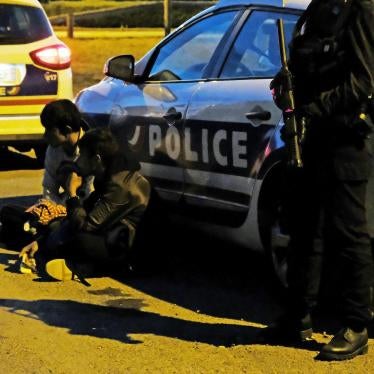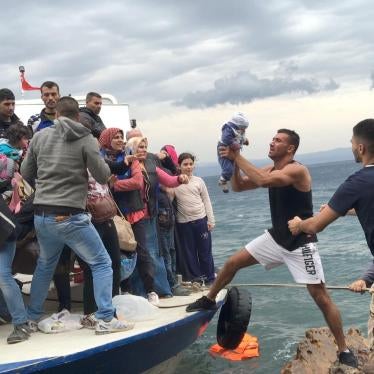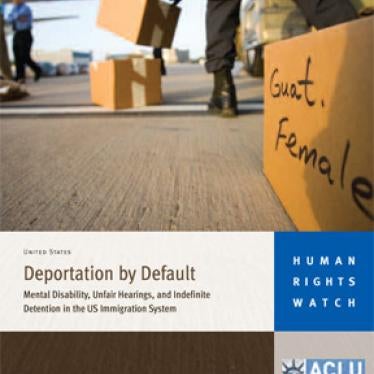A mound of abandoned life jackets on a Greek island. The lifeless body of a small boy on a Turkish beach. A makeshift refugee camp underneath a Hungarian railway station. People seeking safety faced with barbed wire fences and teargas. Acts of kindness by European volunteers.
The refugee crisis will define this moment in Europe’s history. But how will history judge Europe’s response? The signs are less than encouraging.
In theory EU governments recognize that the crisis demands a common response. With prodding by the European Commission, European leaders have agreed on a number of steps to alleviate the crisis.
These include sharing responsibility across the EU member states by relocating 160,000 asylum seekers, most of whom entered the EU through Greece and Italy, and improved coordination along the Western Balkan route to alleviate the suffering of asylum seekers trapped at borders and exposed to the elements. The EU has a common asylum system designed to ensure that all EU states fairly process and humanely host asylum seekers.
The practice has been quite different.
Over the past months, Human Rights Watch researchers have documented the human consequences of the failure of EU governments to marshal an effective coordinated response– people trapped at borders in freezing cold and mud in the Western Balkans, punished simply for crossing a border, shivering on beaches in Greece, and drowning in the Aegean.
The beggar-thy-neighbor approach initiated by Hungary, which combined fences and criminal punishment to deter people from entering its territory, has spread to other governments in the EU and the Western Balkans, with cascading border closures, and the latest move, discriminatory treatment by border police, who restrict entry based on nationality to all but Syrians, Iraqis, Afghans and, depending on the country, one or two others.
There are two notable exceptions. Germany, the preferred destination country for many of those who have arrived in Europe this year, has shown great leadership in welcoming refugees. Sweden has also accepted large numbers of asylum seekers. But the hopes that their examples would encourage other non-frontline EU members to share responsibility have not been realized.
Only 160 people have been relocated under the EU plan. The new government in Poland is backing away from the relocation commitments made by its predecessor. And Hungary and Slovakia, both of which were outvoted in the EU Council on the issue, are seeking to overturn the plan through a legal challenge.
Meanwhile the European Union’s reflex to shift legal and practical responsibility for asylum seekers onto neighboring countries has returned. Following a failed effort at a November summit to persuade African nations to take more responsibility to stem migration flows, the EU firmly set its sights on Turkey as the solution. In late November Brussels and Ankara agreed a migration action plan that aims to prevent migration flows to Europe. In exchange, Europe would provide €3 billion aimed at improving conditions for Syrians in Turkey and the promise to allow visa-free travel in much of the EU for Turkish citizens and to breathe new life into Turkey’s EU membership bid.
But the deal poses serious risks for refugees and asylum seekers. It encourages Turkey to block their path to Europe, raising new prospects for abuse. That includes the potential detention and removal of asylum seekers from Turkey, which already hosts more than two million refugees but lacks effective asylum procedures or protection against deportation to abuse in other countries. Worse still, the agreement signals an EU green light for Turkey to prevent asylum seekers from even crossing its borders to escape from Syria, Iraq, or elsewhere.
And what of the Paris attacks? There is no doubt that the deadliest atrocity in Europe in more than a decade has heightened concerns about the chaos at the EU’s borders, especially since several of the European citizen attackers may have travelled along the same routes to and from Syria posing as refugees. But the fact is that all of the identified attackers were European citizens, not refugees -- at least some of whom are fleeing ISIS abuses in Syria and Iraq.
Better responsibility sharing and cooperation would allow for more orderly processing at Europe’s borders, including security screening. That should be coupled with greater opportunities for asylum seekers to apply for humanitarian visas at European embassies and increased refugee resettlement capacity, both of which would allow for screening before people even reach Europe. The EU should also pursue long-term efforts to create genuine responsibility sharing and common standards across all member states.
Responses by European governments that close the door to asylum seekers or discriminate against Muslims will not prevent home-grown attacks. They would play into the hands of ISIS, which wants to eliminate what it calls the “grey zone” of coexistence between Muslims and non-Muslims in Europe.
The refugee crisis is perhaps the biggest political challenge the European Union has ever faced, and its response during 2015 raises serious questions about its ability to respond in ways consistent with its founding values.
It is not too late. The contours of an effective response are clear. All that is needed is the political will and the desire to be on the right side of history.











